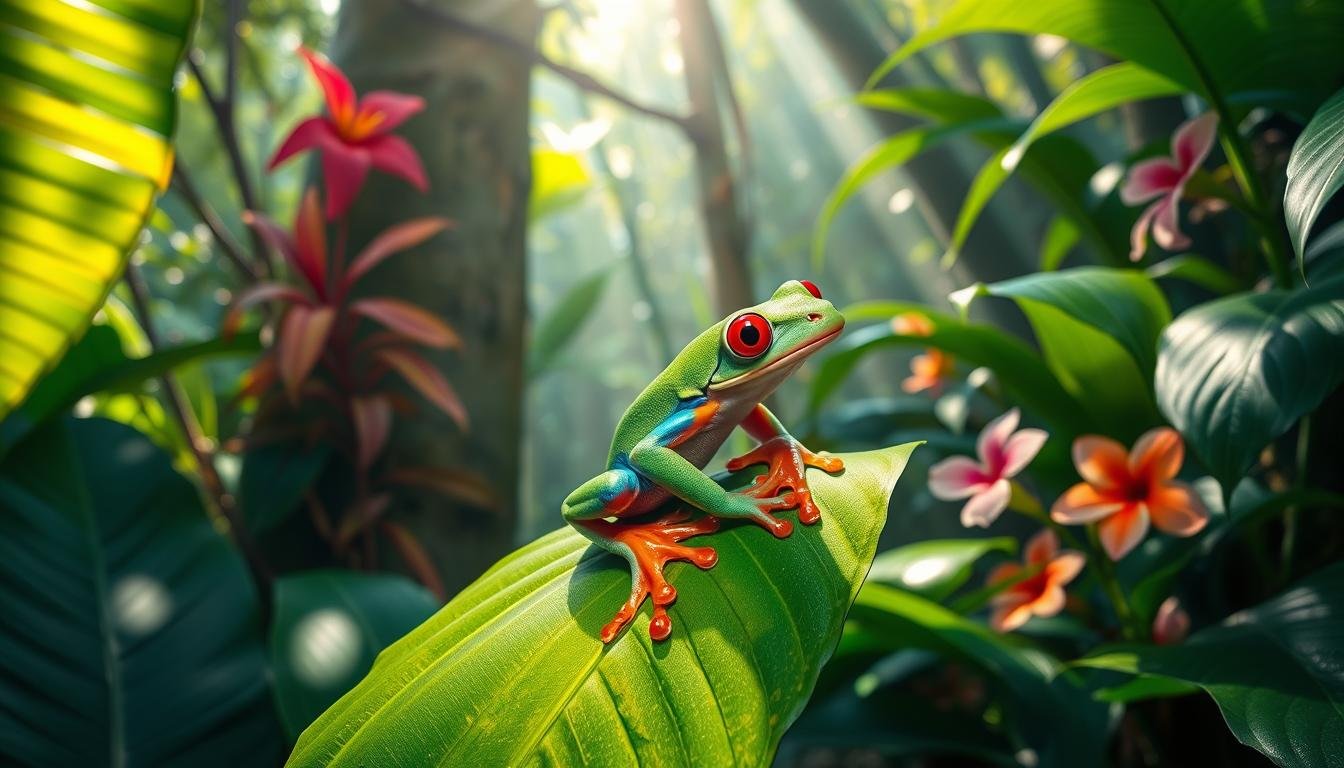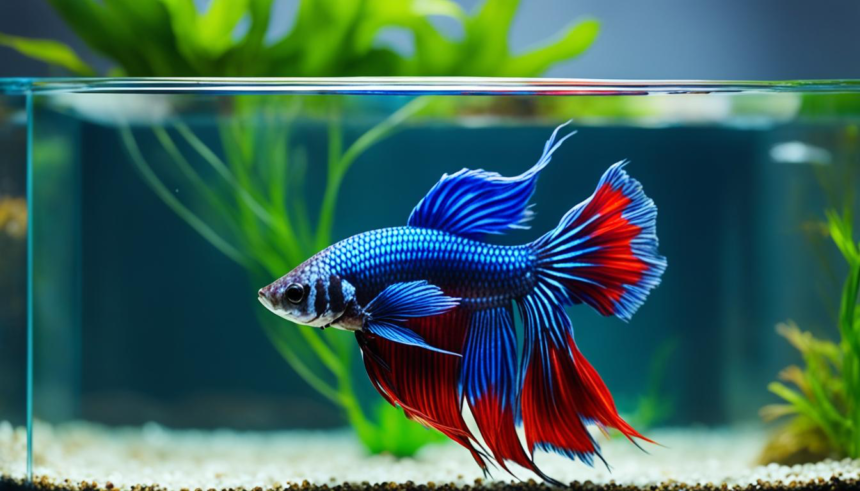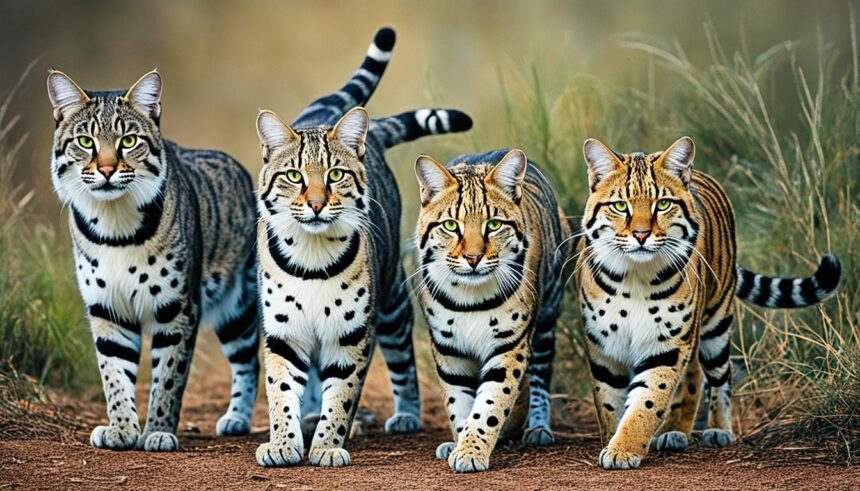The red-eyed tree frog (Agalychnis callidryas) is a top example of how animals adapt in tropical rainforests. These frogs have special survival skills that help them live well in tough places.
Found in Southern Mexico and parts of Central America, these frogs are very good at surviving. They live mostly in trees, using their skills to move around the rainforest canopy with ease.
These frogs stand out because of their bright colors and big red eyes. They have special ways to protect themselves from predators in their dense homes.
Even though they are small, 2-4 cm long, red-eyed tree frogs are very well adapted. They hunt at night, climb with sticky toes, and blend in perfectly. This makes them experts at surviving in the rainforest.
Physical Characteristics of the Red-Eyed Tree Frog
The red-eyed tree frog is a standout amphibian with amazing physical traits. These vibrant creatures have unique features that make them truly special.
Body Size and Structure
Red-eyed tree frogs have a compact yet elegant body. They are 3.8 to 7 cm long, with females being slightly bigger than males. Their slim bodies weigh about 6 to 15 grams, perfect for life in the rainforest canopy.
Distinctive Color Patterns
These frogs are known for their bright colors. Their bodies are a bright green, often called lime green or neon green. This green helps them blend in during the day.
- Bright green dorsal surface
- Blue and yellow flanks
- Bulging red eyes that contrast dramatically with their green body
Webbed Feet and Sticky Pads
The red-eyed tree frog’s orange feet are not just pretty. They have webbed structures and sticky pads for climbing. Their sticky tongues also help them catch prey with great precision.
“Nature has crafted the red-eyed tree frog as a masterpiece of evolutionary design.” – Wildlife Biologist
These physical traits make the red-eyed tree frog a marvel of the animal kingdom. They show how form and function come together in nature.
The Science Behind Their Iconic Red Eyes
Nature has given the red-eyed tree frog a special defense. Their bright red eyes are not just beautiful. They are a clever way to scare off predators.
The bright red color of their eyes is very important. When they feel threatened, they use a trick called startle coloration. They open their eyes, showing a shocking red color that can stun predators.
- The bright red eyes act as a sudden visual shock
- Startle coloration provides a critical escape mechanism
- Green eyelids help camouflage the frog during rest
When the frog is calm, its green eyelids blend with leaves. This helps keep the frog safe by hiding its bright red eyes. The red eyes are only shown when needed.
The red-eyed tree frog’s eyes are nature’s ingenious alarm system – unexpected, dramatic, and potentially life-saving.
Scientists have found that this is a smart survival trick. The sudden red flash distracts predators, giving the frog a chance to get away.
Habitat and Geographic Distribution
Red-eyed tree frogs live in the colorful tropical areas of Central America. They can be found from southern Mexico to the northern parts of South America. Costa Rica is also home to these frogs.
These frogs have learned to thrive in many parts of the tropical rainforests. They show amazing strength and ways to survive.
Tropical Lowland Regions
Red-eyed tree frogs love the rich, diverse tropical lowlands. They can be found in several important countries:
- Belize
- Guatemala
- Honduras
- Nicaragua
- Costa Rica
- Panama
Rainforest Canopy Life
These frogs mostly live in the trees of the rainforest. They have special toe pads that help them climb. This lets them move easily through the leaves and branches.
Water Source Requirements
Even though they live in the trees, red-eyed tree frogs need water. They use rivers, streams, and ponds for breeding and for their tadpoles. In the rainy season, females lay about 40 eggs near water. This helps the next generation grow.
The delicate balance between arboreal life and aquatic reproduction makes red-eyed tree frogs true masters of adaptation in tropical ecosystems.
Red-Eyed Tree Frog Adaptations: Key Survival Mechanisms
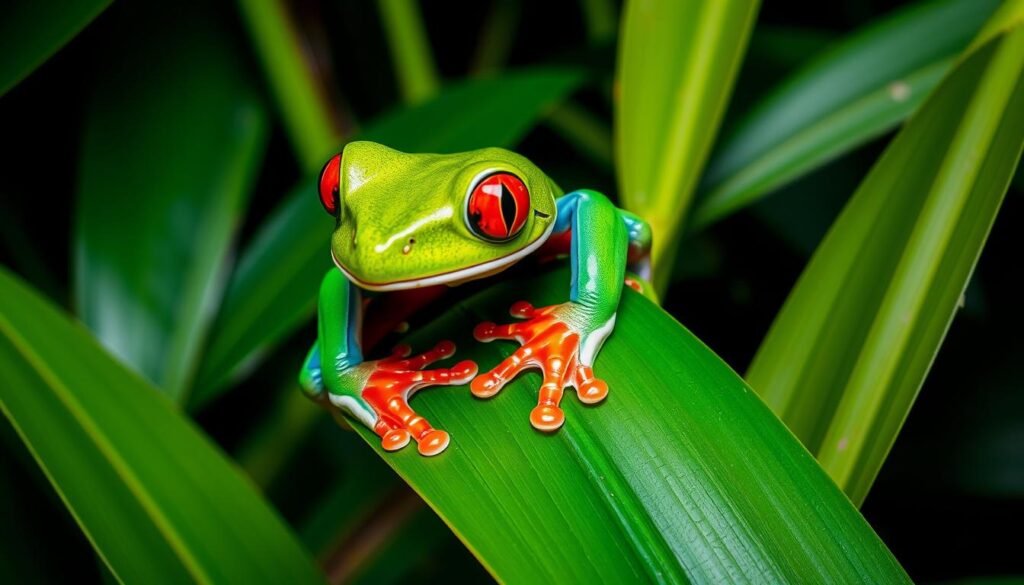
Red-eyed tree frogs have amazing survival strategies. They can thrive in the rainforest thanks to phenotypic plasticity. Their adaptations show how resilient they are in tough tropical environments.
These amphibians have many ways to stay safe:
- Nocturnal behavior to avoid daytime predators
- Advanced camouflage techniques
- Rapid color-changing capabilities
- Strategic environmental blending
They have special traits for navigating the rainforest. Their night hunting and camouflage skills make them experts at survival.
“Nature’s most ingenious survival strategies are often found in the smallest creatures” – Tropical Ecology Research Team
Red-eyed tree frogs are about 2-3 inches long. Females are a bit bigger than males. Their bright colors warn predators and help them blend into their environment.
These frogs show that survival in tough places needs more than strength. It takes smart, adaptable strategies to make the most of their environment.
Nocturnal Hunting Strategies
Red-eyed tree frogs are expert hunters in the dark rainforest. They use special skills to find food. Their hunting ways are key to their survival.
Prey Selection and Feeding Methods
These frogs catch many types of insects. They eat:
- Crickets
- Grasshoppers
- Fruit flies
- Moths
They have fast tongues that catch insects. This skill lets them grab insects from leaves and branches quickly.
Hunting Territory and Patterns
The rainforest canopy is their hunting area. At night, they move around with great night vision. Their big eyes help them see small movements.
Their hunting strategy is a perfect blend of patience and sudden, explosive action.
They sit quietly on branches until prey is close. Their ability to stay very quiet makes them great ambush hunters in the rainforest.
Defensive Coloration and Startle Response
Red-eyed tree frogs have a clever survival plan. They use bright colors and a startle response to protect themselves. This defense helps them blend in with the rainforest.
During the day, these frogs hide well. Their green color makes them almost invisible among leaves. But when danger comes, they show off their bright colors. This can surprise even the most determined predators.
“Nature’s most brilliant defense is often a stunning surprise” – Wildlife Researcher
The frog’s flash coloration is a key survival tactic. Here’s how it works:
- Initially hidden with tucked bright blue and orange flanks
- Suddenly reveals vibrant bright red eyes
- Exposes bright colors to momentarily shock possible attackers
- Creates a split-second chance for escape
Studies show this defense is very effective. Almost 90% of predators are surprised by the frog’s color display. The bright red eyes and sudden color change confuse predators. This gives the frog time to escape.
This shows how amazing evolution can be. It helps small creatures survive in tough tropical places.
Reproduction and Life Cycle Features
Red-eyed tree frogs have amazing ways to make sure their kind keeps going. Their mating is a cool show of how nature works. It’s full of special tricks and biological wonders.
Mating Behavior
When it’s time to mate, male red-eyed tree frogs start a unique courtship. They make special sounds to find a mate. Then, they hold the female in a special way called amplexus to start laying eggs.
Egg-Laying Strategy
Females pick leaves over water to lay their eggs. This keeps the eggs safe from predators. They can lay between 11 to 78 eggs at a time, showing how well they can reproduce.
- Eggs are laid on the underside of leaves
- Leaves are positioned directly above water sources
- Clutch size ranges from 11 to 78 eggs
Tadpole Development
After about a week, the eggs hatch. The tiny tadpoles fall into the water. They go through a big change, growing legs and losing their tails. This takes several weeks.
Nature’s remarkable design ensures these delicate creatures survive through an intricately designed reproductive cycle.
The change from egg to frog is amazing. It shows how well red-eyed tree frogs adapt to their home in the tropics.
Camouflage Techniques During Daytime Rest
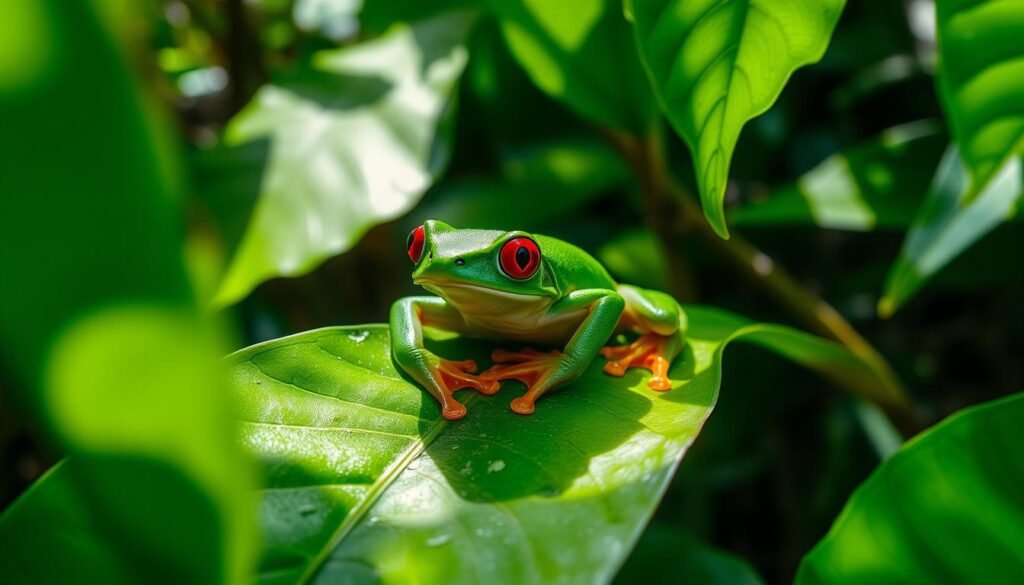
Red-Eyed Tree Frogs are experts at hiding during the day. Their green skin helps them blend in with the rainforest. They use clever ways to stay hidden.
They pick the right spots on leaves and branches to hide. This way, they look just like a part of the forest. Their hiding tricks include:
- Tucking limbs close to their body
- Closing vibrant red eyes
- Hiding body markings covered by strategic positioning
- Matching the green hues of surrounding foliage
When they rest, they look like a green leaf. Their markings are hidden, making them hard to see. This helps them avoid predators.
“Nature’s most brilliant disguise is often the simplest” – Wildlife Biologist
Their camouflage is not just for looks. It also helps them stay alive in the hot rainforest. They can stay very quiet for a long time. This is a clever trick they’ve learned over time.
Predator Avoidance Mechanisms
Red-eyed tree frogs have amazing ways to stay safe from dangers in their home. Their defense tricks show how well they adapt to tough environments.
Flash Coloration Defense
The red-eyed tree frog’s startle coloration is a key survival trick. When they feel threatened, they show off bright colors to confuse predators. This quick change in color is a strong defense.
- Unexpected color revelation disrupts predator focus
- Bright red eyes suddenly open, creating visual shock
- Rapid color display provides critical escape time
Environmental Awareness
These frogs are very good at sensing their surroundings. They can pick up on small changes that mean danger is near. This sharp awareness helps them quickly move away from threats.
Nature has equipped these remarkable frogs with an intricately designed warning system. It turns defense into an art of survival.
Studies show that red-eyed tree frogs can sense threats in many ways. They use vibration sensing and visual signals. This helps them stay safe in their complex rainforest home.
Conclusion
The red-eyed tree frog is more than just a colorful amphibian. It’s not on the IUCN Red List as endangered yet. But, it faces big challenges from losing its home in tropical rainforests. Its survival depends on protecting rainforests in Central America.
Groups like the Amphibian Ark and FrogWatch USA are key in saving these frogs. They help protect these frogs and show us how important rainforests are. The red-eyed tree frog’s bright look and special ways make it a symbol for saving nature.
Scientists and nature lovers know saving the red-eyed tree frog’s home is vital. Without it, these amazing frogs could be in danger from deforestation and climate change. Their story teaches us about the importance of keeping our planet’s most fragile places safe.
As we learn more about these amazing frogs, their future is in our hands. We must keep learning, protecting, and celebrating the diversity of tropical rainforests. The red-eyed tree frog is a symbol of nature’s strength and the need for global conservation.
FAQ
What are red-eyed tree frogs?
Red-eyed tree frogs are colorful amphibians from Central America’s rainforests. They have green bodies and bright red eyes. These small frogs live in trees and are known for their unique defense.
Where do red-eyed tree frogs live?
They live in tropical rainforests from southern Mexico to Central America. Countries like Costa Rica are home to them. They prefer the rainforest canopy, near water like rivers and ponds.
Why do red-eyed tree frogs have such bright red eyes?
Their bright red eyes are a defense. When scared, they open their eyes to shock predators. This gives them time to escape. Their green eyelids help them blend in when they’re calm.
What do red-eyed tree frogs eat?
They eat insects at night. Their diet includes crickets, moths, flies, and grasshoppers. They catch prey with their long, sticky tongues from their tree perches.
How do red-eyed tree frogs reproduce?
Males attract females with croaks during mating season. They mate through amplexus. Females lay eggs on leaves overhanging water. The eggs hatch, and tadpoles drop into water for metamorphosis.
Are red-eyed tree frogs endangered?
They’re not endangered now, but habitat loss is a big threat. Efforts to protect their habitats are vital for their survival.
How big are red-eyed tree frogs?
They’re small, 1.5 to 2.75 inches long. Males are a bit smaller than females. They have long legs and orange webbed feet.
How do red-eyed tree frogs survive in the rainforest?
They use many survival strategies. These include changing appearance, being active at night, camouflage, and a startle defense. During the day, they hide on leaf undersides to avoid predators.

